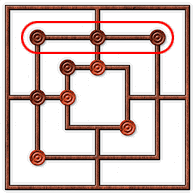Player:
CPU:

1. Introduction
Nine Men's Morris, is a simple board game for two players. It was popular in the 14th century, but earlier versions with fewer than nine pieces have been found dating back to 1400BC.
As with other medieval games, many different rules have evolved over the years. Players are advised to agree on the rules by which they will play before starting. I will indicate which rules are commonly used within the Far Isles, but would not wish to discourage players from trying alternatives.
2. The Board and Pieces
 |
The game is played on a square board, as illustrated. There are 24 points (the corners and the lines which are crossed), and pieces may move between them only along the marked lines. Only one piece may be placed on any point. The players start with nine pieces, with a different colour for each player. Unlike other games, the board is initially empty. The players place their pieces on the board alternately, as described below. |
3. Playing the Game
3.1. Opening Play
The players must decide between them who is to start. The players take turns in placing one piece at a time on any unoccupied point on the board.
Each player attempts to form mills. A mill consists of a straight row of three of the player's own pieces along a marked line. Whenever a player succeeds in making a mill, they may capture (or pound) an opponent's piece. Once captured, pieces cannot be brought back into play.
Most rules forbid the capture of a piece that is within a mill either entirely (references 1, 2, 3), or unless there are no other pieces available (references 4, 5, 6, 7). Generally, the latter rule is used within the Far Isles.
3.2. The Mid-Game
Once both players have placed all of their pieces on the board, they take turns in moving. Pieces may move only to adjacent points along the marked lines.
Players must move if they can (even if it would be to their disadvantage). A player who cannot move loses the game.
Again, the players are trying to form mills, and may capture an opponent's piece whenever one is made.
Rules vary as to how mills may be broken and re-formed. Most allow a piece to move out of a mill, then move back the following go. This provides a clear advantage to the first player who can make a mill.
A variation on this (reference 8) is to require that a minimum number of other moves (not necessarily with the same piece) must be played before a piece may be moved back into the same mill. This could be one, two or three moves. Common practice in the Far Isles is to require that one intervening move must be made. No such restriction applies if a mill is being formed along a different line, or using different pieces.
Finally, some rules require that the new mill must be along a different line (references 6, 8).
3.3 The End-Game
Some versions of the game apply a special rule for movement when a player is reduced to three pieces (references 1, 4, 5). This rule is not commonly played within the Far Isles, but used in this game.
Under this rule, once a player is reduced to three pieces, they are no longer limited to moving only to adjacent points. A piece may instead be moved to any unoccupied point on the board.
Once a player has been reduced to two pieces, they are unable to capture any more of their opponent's pieces, and therefore that player loses the game.
4. References
(1) A. R. Taylor, The Guinness Book of Traditional Pub Games, Guinness Publishing, 1992, ISBN 0-85112-530-1.
(2) R. C. Bell, Board Games from Many Civilisations, Volume 1, Dover Publications Inc, ISBN 0-486-23855-5.
(3) Rules supplied with Cloister Games from Past Times.
(4) Edmund Hoyle, revised by L. H. Dawson, The Complete Hoyle's Games, Wordsworth Reference, ISBN 1-85326-316-8.
(5) D. Pritchard, The Family Book of Games, Brockhampton Press, ISBN 1-86019-021-9.
(6) Rules supplied with Nine Men's Morris from John Millman Traditional Toys & Games.
(7) "Alair of the Bloody Fountain", Three Popular Board Games in Indoor Games, or How to While Away a Siege, The Compleat Anachronist #4, Society for Creative Anachronism.
(8) P. J. Smith, Period Pastimes, The Compleat Anachronist #71, Society for Creative Anachronism.
(9) R. C. Bell, Board Games from Many Civilisations, Volume 2, Dover Publications Inc, ISBN 0-486-23855-5.